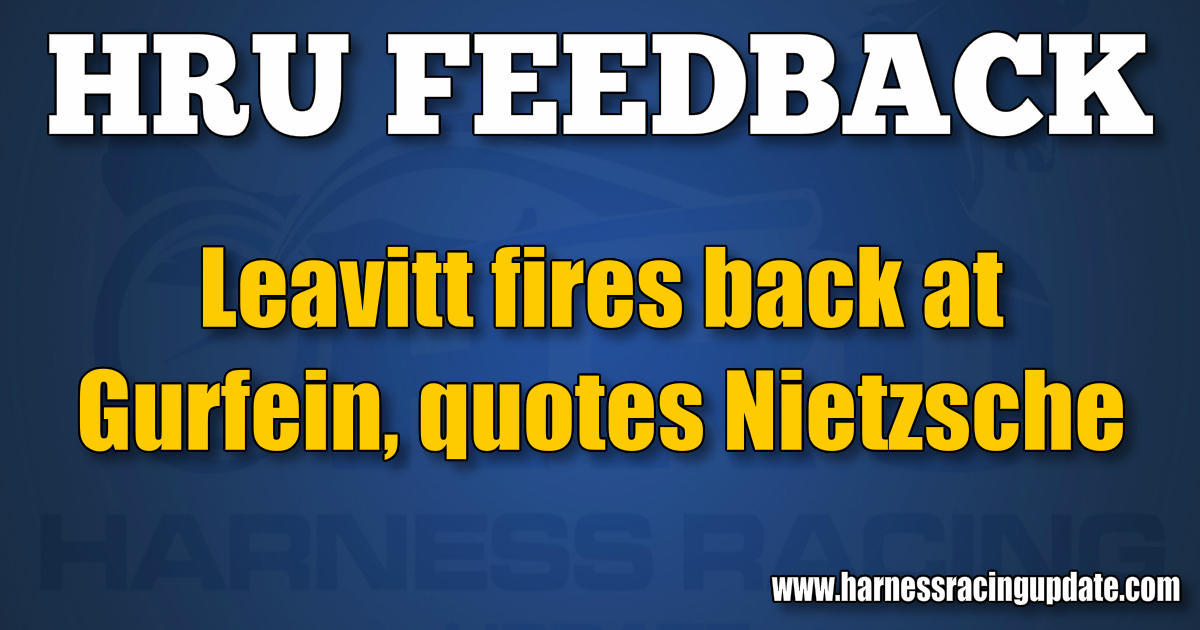HRU Feedback (2020-05-10)
Leavitt responds to Gurfein, quotes Nietzsche
Ronnie Gurfein completely misses the point when he sees the problem in creating a commissioner of harness racing as a lack of parity between the states (full story here).
The fact that different states regulate our sport differently is simply an offshoot of the fact that every state is an entity unto itself, with not the slightest inclination to sharing one drop of its authority with any outside entity, such as a Commissioner of harness racing.
Money also plays a role here. Every state collects a fee for every license it issues and they grasp at every penny they see. Ronnie seems to think that after the USTA and Standardbred Canada put together their little committees, the various state commissions will be susceptible to giving up their authority to those committees. Dream on.
I’ve also never heard that greatness comes from change before I read it in Ronnie’s column. I think one could make a better case that greatness comes from courage and a deep devotion to honesty. Being clear headed and clear thinking also plays a role. Before I follow Ronnie’s thoughts on the subject, I’ll feel more comfortable with the writings of Nietzsche.
As he said, “Our friends show us what we can do. Our enemies show us what we must do.”
I was under the impression that Gurfein’s role was to answer horsemen’s question about training and rigging. Now he ranges far afield, with unrequested opinions on many matters, plus a healthy dose of ego tripping. If Ronnie aspires to personal greatness, he should understand that the first prerequisite is humility.
—Alan Leavitt / Lexington, KY
Thanking Leavitt
I would like to thank Alan Leavitt for his guest column (full story here) on why there will never be a harness racing commissioner. I hope this will put an end to HRU publishing more letters to the editor calling for a commissioner.
—David Haaker / Livingston, NJ
Harness racing should follow NASCAR’s lead on a commissioner
With great interest, I read Alan Leavitt’s HRU article (full story here) on why there will never be a commissioner in harness racing. He makes a number of many strong points comparing the differences between harness racing and the major sports in this country. While those comparisons have relevancy, he left out the sport that has a commissioner and is the most closely aligned with harness racing — and that is NASCAR.
NASCAR also races in different states that race under different rules and regulations. As Mr. Leavitt noted, the owners in baseball created the Commissioner. That is what team owners did in basketball, football and hockey, also. They knew that if they wanted their sports to succeed, they had to yield their control. He also notes that states will not “relinquish one iota of its power.” An interesting choice of words. Because it is not the states that have to relinquish their power to create a commissioner’s office. It is the harness racing cliques that are not being as financially impacted by the downturn in harness racing that needs to relinquish its power, and it looks like Mr. Leavitt speaks for them.
Following the model which turned NASCAR from a regional oddity in to a national success story by giving power to a commissioner, it is the horsepeople and ONLY the horsepeople who can create a commissioner’s office to oversee the game. That is what NASCAR did. It was the drivers and the car owners, not the racetracks, that decided on a commissioner.
Breeders and sales companies do not want a commissioner. As the supply of horses decreases, the demand goes up and you see what the prices are at sales. Of course, the dwindling supply also means an eventual end to racing, but as the old saying goes, “make hay while the sun shines.”
Owners, drivers and trainers, the ball is in your court. Do you want harness racing to continue, or do you want the Alan Leavitt’s of the world tell you that you have no future?
—Gil Winston / Manalapan, NJ
Gurfein’s commissioner committee lacks balance
I have a comment about Ron Gurfein’s suggestion that a committee be appointed to come up with a plan for designating a National Commissioner of Racing (full story here). I do not oppose the idea in concept, although I also believe that because of the territorial attitudes of the various racing commissions, such an effort is highly unlikely to succeed. My immediate quibble is with the tentative roster for the committee that Ron suggested. It is certainly true that all five of Gurfein’s suggestions are eminent and qualified. The problem is that because they consist of four trainer/drivers and one racetrack operator, they represent a relatively small segment of the harness racing industry. Where is the representation for owners and breeders, for example? The inclusion of a state or provincial regulator who is known to support the idea would also give it greater credibility. Populating the committee in that manner is not only fair, it would enhance the possibilities of success for an exercise that is questionable at best.
—Steve McCoy / USTA director
Murray Brown responds to Gary Kay
With reference to Attorney Gary Kay’s letter to the editor in last Sunday’s HRU (2020-05-03 Feedback) just for the sake of argument, let’s assume that he is correct.
He says that 2-year-olds should not be raced.
Has Mr. Kay addressed or even thought about the practicality of his suggestion?
Two major questions come to mind.
1. In order to practically implement such a suggestion, the land holdings of just about every breeder would have to be increased by a factor of approximately 40 per cent or more.
The vast majority of breeders are losing money or just scraping by.
Assuming that such land is available and that the breeder can afford to buy it and also assume the extra costs associated with tending to it and the horses on it, why would they want to do so? I would guarantee, that at least some and perhaps the majority would just say ENOUGH and just get out of the breeding business. We are not breeding enough horses to fill our cards(in non-COVID-19 circumstances) today. Doing that would further increase a significant problem.
2. I wonder if Mr. Kay has ever raised a group of yearlings, specifically a group of stud colts. It’s difficult enough when you’ve got a group of yearling boys out there together beating up on and trying to mount each other. As they grow older they become more studdy, stronger and much more inclined to inflict injury upon each other. It happens with all too much frequency as yearlings. A multiplier effect would certainly take effect when they become full-fledged stallions.
Oh, I know. Let’s make geldings of all of them.
Discounting the probable damage it would do to the breed, it would almost certainly affect the growth and strength of the male horses.
Mr. Kay, I haven’t seen all that many yearling geldings, but I’ve seen quite a few. Without exception, they haven’t had the same masculine features and level of physical maturity that a normal colt has. Simply put, you are preventing it from becoming the horse it is meant to be at perhaps the time of its life when it grows and matures the most.
I am not completely discounting the possibility that Mr. Kay’s premise might be correct, although even if I were in the financial position to try it, I wouldn’t.
But there is nothing that prevents Mr. Kay from doing it himself and showing us all the merits of his theory.
There is no greater proof than success.
—Murray Brown / Boca Raton, FL
What have we learned while racing has been halted?
Okay, we’re all ready for the return of harness racing but what have we learned moving forward?
• As we look at current thoroughbred racing we see an over-abundance of longshots winning and off-the-board favorites (statistical anomalies — yea right). Considering the recent indictments perhaps the fear of further scrutiny is playing a major role here and this is to some degree to be expected. What was not expected is the obvious in-actions of the local and state oversight. Numerous 1-2 and 3-5 favorites back up through the field and no questions? Is the track veterinarian actually verifying the race worthiness of all animals prior to all races?
• Now to harness racing, with an in-your-face understanding that the Feds have and are finally involved in the sport, what positive steps have been taken AND announced by tracks (except for the Meadowlands) in the 2+ months the tracks have been down? Does this tell you about how important you are to the tracks? Have the tracks solicited feedback from the fans/bettors, trainers or owners and implemented changes to move the sport forward? I think not.
• If we don’t take this time to demand change now, perhaps WE become the major factor in the integrity issue. The Feds are currently involved and listening maybe now is a good time for a write-in campaign. If, the tracks are truly on our side then now would also be the ideal time for a statistical audit of previous racing outcomes should be a no-brainer. The numbers don’t lie and the data is available, all that is lacking is a nudge from the public.
• Without continuing, meaningful change at most tracks, we are being driven to wagering at only two major tracks, one in Toronto and one in New Jersey.
• There is still time and I’m rooting for the right actions at the many smaller venues. So, once again the ball is in your court — fix it or build condos on the property.
—David Perry / Dearborn, MI

















